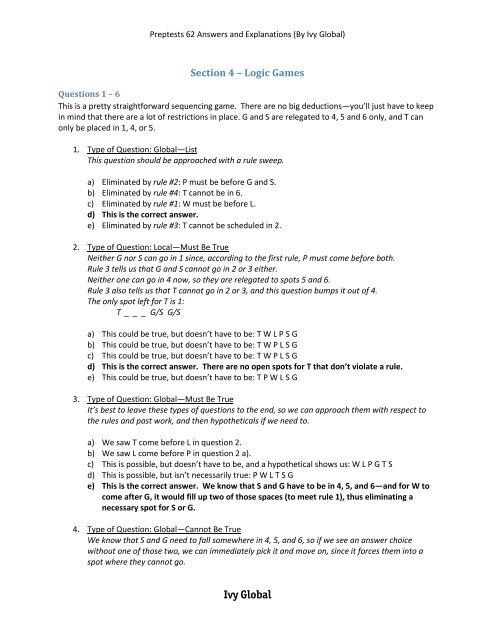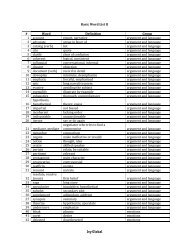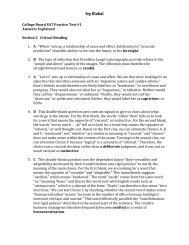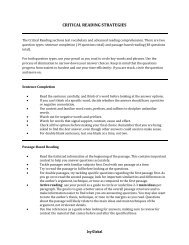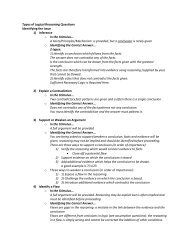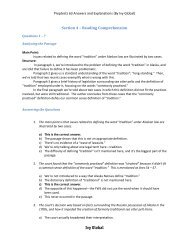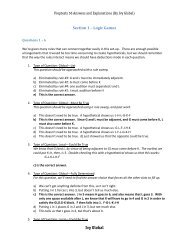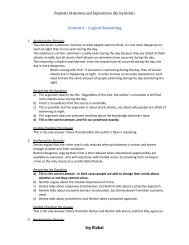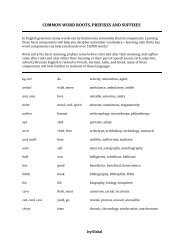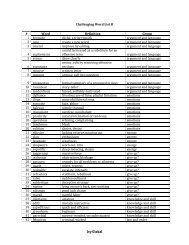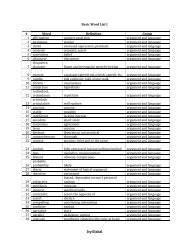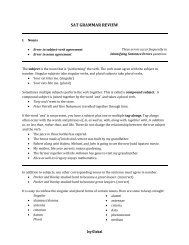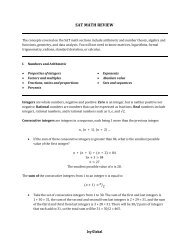Logic Games Answers - Ivy Global
Logic Games Answers - Ivy Global
Logic Games Answers - Ivy Global
You also want an ePaper? Increase the reach of your titles
YUMPU automatically turns print PDFs into web optimized ePapers that Google loves.
Preptests 62 <strong>Answers</strong> and Explanations (By <strong>Ivy</strong> <strong>Global</strong>)Section 4 – <strong>Logic</strong> <strong>Games</strong>Questions 1 – 6This is a pretty straightforward sequencing game. There are no big deductions—you’ll just have to keepin mind that there are a lot of restrictions in place. G and S are relegated to 4, 5 and 6 only, and T canonly be placed in 1, 4, or 5.1. Type of Question: <strong>Global</strong>—ListThis question should be approached with a rule sweep.a) Eliminated by rule #2: P must be before G and S.b) Eliminated by rule #4: T cannot be in 6.c) Eliminated by rule #1: W must be before L.d) This is the correct answer.e) Eliminated by rule #3: T cannot be scheduled in 2.2. Type of Question: Local—Must Be TrueNeither G nor S can go in 1 since, according to the first rule, P must come before both.Rule 3 tells us that G and S cannot go in 2 or 3 either.Neither one can go in 4 now, so they are relegated to spots 5 and 6.Rule 3 also tells us that T cannot go in 2 or 3, and this question bumps it out of 4.The only spot left for T is 1:T _ _ _ G/S G/Sa) This could be true, but doesn’t have to be: T W L P S Gb) This could be true, but doesn’t have to be: T W P L S Gc) This could be true, but doesn’t have to be: T W P L S Gd) This is the correct answer. There are no open spots for T that don’t violate a rule.e) This could be true, but doesn’t have to be: T P W L S G3. Type of Question: <strong>Global</strong>—Must Be TrueIt’s best to leave these types of questions to the end, so we can approach them with respect tothe rules and past work, and then hypotheticals if we need to.a) We saw T come before L in question 2.b) We saw L come before P in question 2 a).c) This is possible, but doesn’t have to be, and a hypothetical shows us: W L P G T Sd) This is possible, but isn’t necessarily true: P W L T S Ge) This is the correct answer. We know that S and G have to be in 4, 5, and 6—and for W tocome after G, it would fill up two of those spaces (to meet rule 1), thus eliminating anecessary spot for S or G.4. Type of Question: <strong>Global</strong>—Cannot Be TrueWe know that S and G need to fall somewhere in 4, 5, and 6, so if we see an answer choicewithout one of those two, we can immediately pick it and move on, since it forces them into aspot where they cannot go.<strong>Ivy</strong> <strong>Global</strong>
Preptests 62 <strong>Answers</strong> and Explanations (By <strong>Ivy</strong> <strong>Global</strong>)e) This is the correct answer.5. Type of Question: Local—Must Be TrueWe already know that W can’t be 6 (L must come after it, as per rule 1), P can’t be 6 (G and Smust come after it, as per rule 2), and T can’t be 6 (as per rule 4). Now, we’re told that both Gand S can’t fall on 6, so that leaves only L.b) This is the correct answer.6. Type of Question: <strong>Global</strong>—SubstitutionFor this question we’ll have to find an answer choice that stops T from going in 6 and doesn’tcreate any other restrictions.a) This is the correct answer. We know G and S have to be in 4, 5, or 6, so T will have tocome before at least one of them.b) We’ve seen many cases where T is not immediately before G or S—when T falls in 1.c) We saw L come before T in question 3 c).d) We saw G come before T in question 3 c).e) L could also fall on 6.Questions 7 – 13This is a particularly long and difficult game, but it is manageable if you make a key inference.Rule #3 and #4 combine into an important inference. Y is never with G or O, and without O, we musthave P. This means Y will always occur with P.With this inference, we know we have two windows with R, one window with GP, and onewindow with PY.7. Type of Question: <strong>Global</strong>—ListThis question should be approached with a rule sweep.a) Eliminated by rule # 4: Each window must have O or P.b) This is the correct answer.c) Eliminated by rule #1: Exactly one window must contain G and P.d) Eliminated by rule #3: Y cannot be paired with O.e) Eliminated by rule #2: Exactly two windows have R.8. Type of Question: <strong>Global</strong>—Cannot Be TrueWe should go through this with reference to the rules, past work, and hypotheticals if necessary,so it should be left until the end.a) We saw this in question 13.b) We saw this in question 10.c) This is the correct answer. Each window must have one of either P or O in it.d) We saw this in question 11.e) We saw this in question 9.9. Type of Question: Local—Could Be True<strong>Ivy</strong> <strong>Global</strong>
Preptests 62 <strong>Answers</strong> and Explanations (By <strong>Ivy</strong> <strong>Global</strong>)Since Y can’t be present with P, and we already have two spots filled with R, we can set up ourbase diagram for this question like so:R R YO/P O/P PWe know that G must also be present once with P, and so that can go in one of the first twowindows.a) We can never have R and Y together without P.b) This is the correct answer, and the set-up could look like this:R R YO P PGc) This doesn’t work in our diagram.d) We always need P or O in each window.e) This doesn’t work in our diagram.10. Type of Question: Local—Could Be TrueWe’re told the set up of one window: P, R, O. We know that we still need a window with R, awindow with G and P, and a window with Y and P. We also know that the G/P and Y/P windowscan’t be combined, since G and Y can’t be together. So, we get a set-up that looks like this:R R PP P Y/GO Y/Ga) This isn’t possible.b) This is the correct window. The set-up could look like this:R R PP P GO Y Oc) This isn’t possible.d) This isn’t possible.e) This isn’t possible.11. Type of Question: Local—Could Be True?? a12. Type of Question: Local—Could Be TrueWe know that R can’t be used in every window, since rule 2 tells us only two windows contain R.Y can’t be in all three windows, since it can’t be with G or O.G and O also can’t be used in all three windows, because then we wouldn’t be able to place Gand O.We’re left with P.c) This is the correct answer.13. Type of Question: Local—Must Be TrueWe now know one colour for each window: R, R, and O. Y can’t be with O, so we know that onewindow will have to be R, P, Y.<strong>Ivy</strong> <strong>Global</strong>
Preptests 62 <strong>Answers</strong> and Explanations (By <strong>Ivy</strong> <strong>Global</strong>)e) This is the correct answer.Questions 14 – 18When we have a game where there are more open spaces (in this case, 10) than entities (8), it’s best toadd in two extra entities. We’ll denote these with an X. In this case, we know for sure that one of the“Handling People” spaces has an X under it. The set-up will look like this, then:F G H I L_ _ x _ __ _ _ _ _(Q Q R R S S T T X X)14. Type of Question: <strong>Global</strong>—ListThis question should be approached with a rule sweep.a) Eliminated by rule #3: S and T cannot attend the same talk.b) Eliminated by rule #2: R cannot attend “Handling People”c) This is the correct answer.d) Eliminated by rule #4: Q must attend T’s first talke) Eliminated by rule #5: S must attend R’s first talk15. Type of Question: Local—Must Be TrueIn this case, we know that F, G, I, and L will all be filled with two people each. Rule #1 bars Qfrom attending Feedback, and rule #4 then requires that T cannot attend either. This means weneed S and R in Feedback.F G H I LS _ x _ _R _ x _ _a) This is the correct answer.b) This could be true, but doesn’t have to be.c) This could be true, but doesn’t have to be.d) This could be true, but doesn’t have to be.e) This could be true, but doesn’t have to be.16. Type of Question: Local—Could Be TrueWe know for sure that R and S can’t attend Handling People together, since only one personattends the talk. We also know that they cannot attend Goal Sharing together, because of rule#2. After this, there are no real restrictions about Feedback, Information, or Leadership—theycould attend any of these.a) This is the correct answer.b) They cannot attend Goal Sharing.c) Feedback is missing.d) Information Overload is missing.e) Leadership is missing.<strong>Ivy</strong> <strong>Global</strong>
Preptests 62 <strong>Answers</strong> and Explanations (By <strong>Ivy</strong> <strong>Global</strong>)17. Type of Question: Local—Could Be FalseThis added stipulation fills up our “X” quota, so we know that Feedback, Goal Sharing, andInformation will all have two parties each. Again, this means that R and S will attend GoalSharing. Then, because of the requirement that Q attends T’s first seminar, and since we knowthe last talk is filled with Q alone, Q and T will need to attend Goal Sharing together:F G H I LR Q x R xS T _ _ Qa) This must be true.b) This must be true.c) This must be true.d) This is the correct answer. T could attend Handling People.e) This must be false.18. Type of Question: Local—Could Be FalseOnce again, we know that Feedback and Goal Sharing must be filled, so Feedback will hold R andS, and Goal Sharing will hold Q and T. Since only T or S can sit in Handling People, Q will have toattend Leadership:F G H I LR Q x x QS T _ R _a) This must be true.b) This must be true.c) This must be true.d) This must be true.e) This is the correct answer. S could attend Handling People.Questions 19 – 23There is really not much to be deduced in this game. Keep track of the rules (especially the ST/SU andTM/WM rules) and make sure you move them around as the question requires. Otherwise, this is afairly straightforward linear game.19. Type of Question: <strong>Global</strong>—ListThis question should be approached with a rule sweep.a) Eliminated by rule #2: U must testify before R and W.b) This is the correct answer.c) Eliminated by rule #3: T or W must testify immediately before M.d) Eliminated by rule #1: S must testify immediately before T or U.e) Eliminated by rule #2: U must testify before R and W.20. Type of Question: Local—Could Be TrueIf we place T in 1, then we know that S must be immediately before U. The answer choice willfollow the chain straight through, depending on if M immediately follows T or W:<strong>Ivy</strong> <strong>Global</strong>
Preptests 62 <strong>Answers</strong> and Explanations (By <strong>Ivy</strong> <strong>Global</strong>)T M S U R/W R/WT S U _ _ _a) This isn’t possible.b) This isn’t possible.c) This isn’t possible.d) This isn’t possible.e) This is the correct answer. The second option would allow for this to play out: T S U R WM21. Type of Question: Local—Must Be TrueIf S testifies fifth, then T must testify in 6 (because rule #2 could not be satisfied with U in 6.) Weknow then that M will follow W—so in order for the chain U—R & WM to play out, U must sit in1:U _ _ _ S Ta) This is the correct answer.22. Type of Question: <strong>Global</strong>—Cannot Be TrueThis question should be approached with reference to the rules, past work, and hypotheticals ifneeded.a) This is the correct answer. U and W would have to sit in spot 1 and 2 to fulfill rules 2 and3, and doing so would violate rule 1.b) This is possible: U W R S T Mc) This is possible, and we saw it in question 20.d) This is possible: S U T R W Me) This is possible, and we saw it in question 20.23. Type of Question: <strong>Global</strong>—Cannot Be TrueThis question should be approached with reference to the rules, past work, and hypotheticals ifneeded.a) This is possible, and we saw it as a hypothetical in question 22 d.b) This is possible, and we saw it in question 20.c) This is possible, and we saw it in question 20.d) This is the correct answer—it doesn’t allow for rule 1 to be fulfilled.e) This is possible, and we saw it in question 21.<strong>Ivy</strong> <strong>Global</strong>


